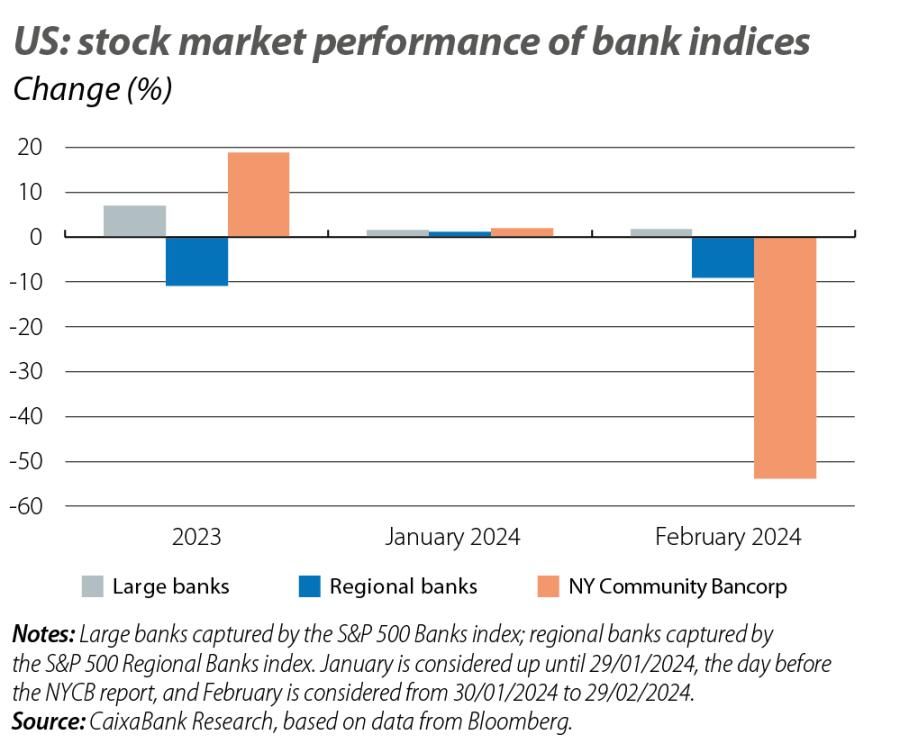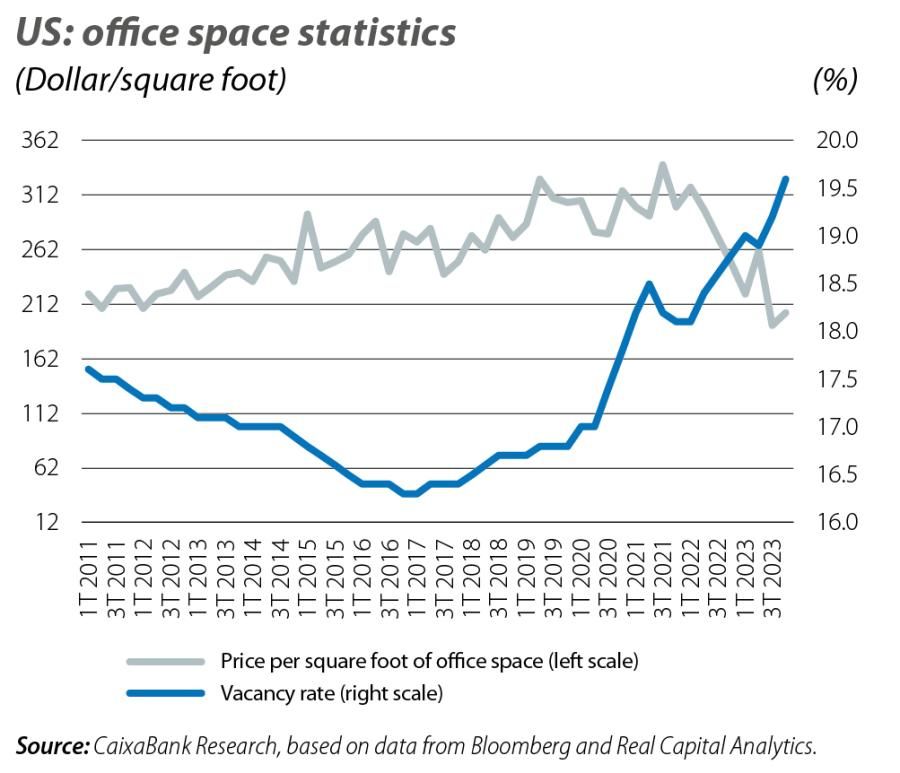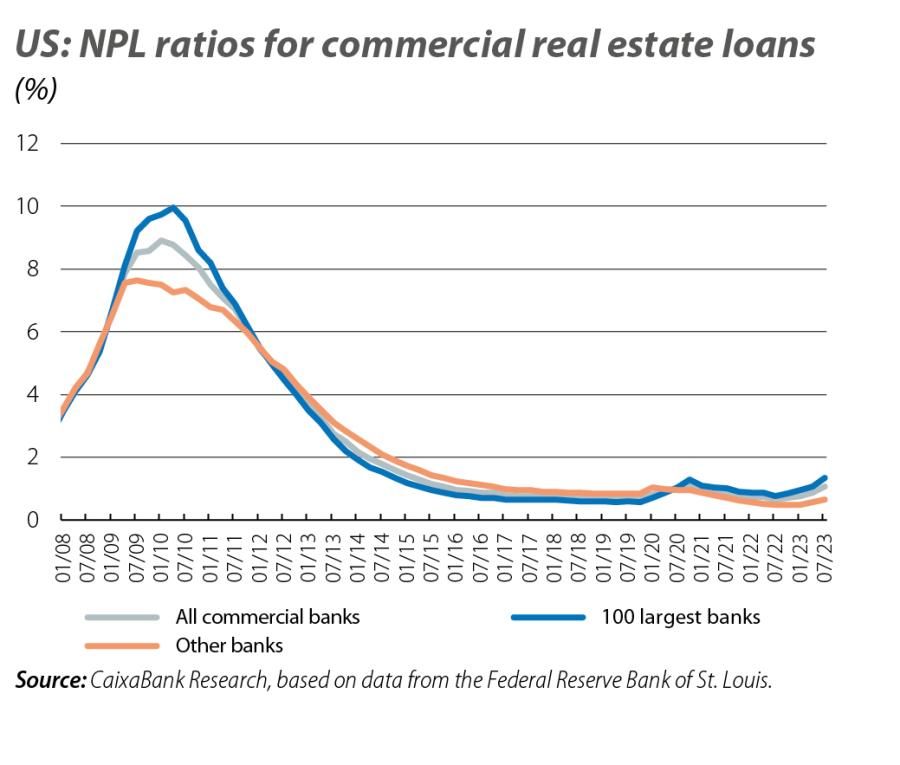Risks in the US commercial real estate sector
We examine the current state and the particularities of the commercial real estate sector in the United States, and the extent of the banking sector’s exposure, following the collapse in the share price of New York Community Bancorp.

At the end of January, New York Community Bancorp (NYCB) shares, a bank specialised in the office and multi-family residential real estate sector in the New York metropolitan area, plummeted 38% in a single day, after reporting losses and increasing provisions. Is this a new indication of latent risks in the US commercial real estate sector?
In the space of just a few months, NYCB1 went from being a small, specialised institution to being a bank with over 100 billion dollars in assets following the acquisition of Flagstar Bank, based in the state of Michigan, and Signature Bank, one of the banks that failed in the wake of the turbulence of March 2023. Following these changes, at the end of January the bank announced a 70% dividend cut aimed at boosting liquidity, in addition to sharply increasing its provisions (by over 700%) to protect against the risk of potential losses in its loan portfolio. While both decisions were presented as measures aimed at adapting to regulatory requirements, they occurred in the midst of weakness in the US commercial real estate sector and they were announced together with the bank’s Q4 2023 losses (in addition to the acknowledgement of issues with two large loans, one related to office buildings and the other to apartment buildings). The financial markets heavily penalised these announcements, causing NYCB’s share price to plummet, and it is currently down more than 50% since then. Additionally, the episode caused some contagion, with other regional bank stocks currently trading 10% down as part of a risk-off movement in the face of fears that the troubles in the US commercial real estate sector could begin to cause difficulties for the most exposed banks. In contrast, the big banks, with much less exposure, were barely affected by the unease.
- 1. The cut-off date for this article was 29 February. Since then, and up until the cut-off date for this Monthly Report, NYCB has undergone a change of leadership after identifying weaknesses in its internal controls related to loans, it has revised its reported losses upwards and has received an injection of capital of 1 billion dollars. The cumulative loss in its share price as of the close of this report was 65%.

The commercial real estate sector is diverse and includes various different segments, each one with its own characteristics and risks, so not all of them are necessarily in trouble. On the one hand, the retail segment (ranging from shops to florists, to cafés and any other retail establishment) has benefited from the strength of consumption in the US economy, while the industrial segment (mainly warehouses and distribution centres) has been spurred on by the rapid growth of e-commerce since the pandemic.
The situation in the multi-family homes and office segments is different. The former has seen a recent rise in vacancy rates. In addition, some cities such as New York, Los Angeles and San Francisco have implemented price controls which limit rent increases in certain areas. However, generally speaking the sector does not appear to be suffering from a structural problem, since the lack of housing supply in the US, along with the high interest rates (which cool the demand for mortgages and thus for home purchases), can be expected to act as supports in the medium term.

In contrast, the office segment is currently going through a rough patch, and it is doing so in the midst of structural changes, especially those derived from the habits adopted after the pandemic, with remote and/or hybrid work having become the new norm and reducing the demand for office space. Office vacancy rates have surged and are now approaching 20% across the country as a whole. Moreover, the occupancy rate of newly built offices is at a low: according to data from Bloomberg, of the 24.5 million square feet of construction completed in 2023, only 4.8 million were occupied.2 Thus, oversupply has limited rental prices and depreciated
the value of properties; so much so that office property prices have fallen by as much as 40% since the peak reached in 2021.
In addition, there is the risk posed by refinancing. A study published by the NBER3 estimates that, in 44% of office loans, the market value of the property is lower than the outstanding loan balance associated with it. Moreover, in a context of high interest rates, it is estimated that in 2024 and 2025, loans to the tune of 150 billion and 300 billion dollars, respectively, will mature and need to be refinanced.
According to data from the Fed, the market for loans to the commercial real estate sector is worth 3.5 trillion dollars (as of October 2023), of which 2.7 trillion is in the hands of commercial banks. This amount represents, in aggregate, 25% of the total loan portfolio of US banks and 13% of their assets. However, the proportions vary and exposure to the commercial real estate sector is most relevant in regional banking: for the 25 biggest banks, which hold 30% of all the commercial real estate loans that are in the hands of commercial banks, this sector represents only 13% of their loan portfolio, and the office segment specifically represents just 3%. In contrast, for the rest of the small regional banks, which hold the remaining 70% of the loans to the sector, it is 44% of their portfolio.

Beyond the extent of the banking sector’s exposure, other figures are more reassuring. Delinquency rates remain historically low for now. The median loan-to-value ratio in regional banks for commercial real estate loans is 58%, a conservative figure. In recent simulations conducted by the St. Louis Fed, they estimate that if the entire portfolio of commercial real estate debt were to lose 10% of its value, the banks that would fall into insolvency would account for just 2% of the assets of the entire American banking system. In this regard, the words of Fed Chair Jerome Powell and Treasury Secretary Yanet Yellen offer a balanced analysis of the situation: both have acknowledged that the weakness of the commercial real estate sector poses a problem, insofar as some small and regional banks have significant exposure and it is likely that there will be losses, but it is a source of risk which they have been monitoring for a long time, they consider it to be «manageable» and they are «working with them [small banks]». After all, over the coming quarters, and beyond the respite that the Fed’s first rate cuts may provide, the structural difficulties in the sector are likely to persist, especially in the offices segment, and the environment can be expected to remain challenging.




